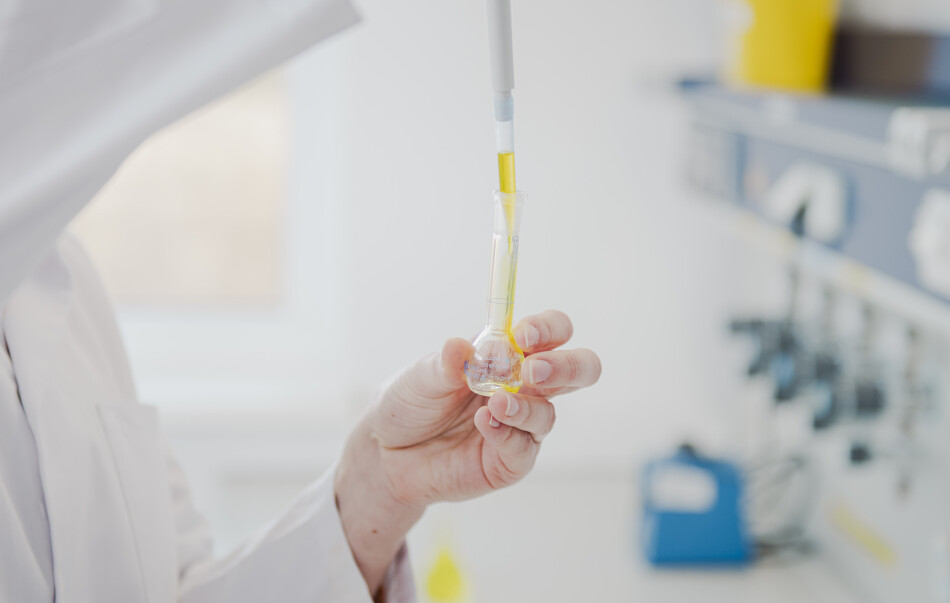Assays
according to Pharmacopoeias (PH.EUR. / USP / JP).

Overview of methods:
The acid value IA is the number that expresses, in milligrams the quantity of potassium hydroxide required to neutralise the free acids present in 1 g of the substance.
The ester value IE is the number that expresses in milligrams the quantity of potassium hydroxide required to saponify the esters present in 1 g of the substance.
The hydroxyl value IOH is the number that expresses in milligrams the quantity of potassium hydroxide required to neutralise the acid combined by acylation in 1 g of the substance.
The iodine value II is the number that expresses in grams the quantity of halogen, calculated as iodine, that can be fixed in the prescribed conditions by 100 g of the substance.
The peroxide value IP is the number that expresses in milliequivalents of active oxygen the quantity of peroxide contained in 1000 g of the substance, as determined by the methods described below.
The saponification value IS is the number that expresses in milligrams the quantity of potassium hydroxide required to neutralise the free acids and to saponify the esters present in 1 g of the substance.
The term “unsaponifiable matter” is applied to the substances non-volatile at 100-105 °C obtained by extraction with an organic solvent from the substance to be examined after it has been saponified. The result is calculated as per cent m/m.
Place a quantity of the substance to be examined (m g) containing about 2 mg of nitrogen in a combustion flask, add 4 g of a powdered mixture of 100 g of dipotassium sulfate R, 5 g of copper sulfate pentahydrate R and 2.5 g of selenium R, and three glass beads. Wash any adhering particles from the neck into the flask with 5 mL of sulfuric acid R, allowing it to run down the sides of the flask, and mix the contents by rotation. Close the mouth of the flask loosely, for example by means of a glass bulb with a short stem, to avoid excessive loss of sulfuric acid. Heat gradually at first, then increase the temperature until there is vigorous boiling with condensation of sulfuric acid in the neck of the flask; precautions should be taken to prevent the upper part of the flask from becoming overheated. Continue the heating for 30 min, unless otherwise prescribed. Cool, dissolve the solid material by cautiously adding to the mixture 25 mL of water R, cool again and place in a steam-distillation apparatus. Add 30 mL of strong sodium hydroxide solution R and distil immediately by passing steam through the mixture. Collect about 40 mL of distillate in 20.0 mL of 0.01 M hydrochloric acid and enough water R to cover the tip of the condenser. Towards the end of the distillation, lower the receiver so that the tip of the condenser is above the surface of the acid. Take precautions to prevent any water on the outer surface of the condenser from reaching the contents of the receiver. Titrate the distillate with 0.01 M sodium hydroxide, using methyl red mixed solution R as indicator (n1 mL of 0.01 M sodium hydroxide).
Repeat the test using about 50 mg of glucose R in place of the substance to be examined (n2 mL of 0.01 M sodium hydroxide).
Complexiometric titration is used to test for the following substances: Aluminum, bismuth, camclium, magnesium, lead and zinc.
The semi-micro determination of water is based upon the quantitative reaction of water with sulfur dioxide and iodine in a suitable anhydrous medium in the presence of a base with sufficient buffering capacity.
The coulometric titration of water is based upon the quantitative reaction of water with sulfur dioxide and iodine in an anhydrous medium in the presence of a base with sufficient buffering capacity. In contrast to the volumetric method described in general chapter 2.5.12. Water: semi-micro determination, iodine is produced electrochemically in the reaction cell by oxidation of iodide. The iodine produced at the anode reacts immediately with the water and the sulfur dioxide contained in the reaction cell. The quantity of water in the substance is directly proportional to the quantity of electricity (in coulombs), corresponding to electric current (in amperes) multiplied by time (in seconds), used for iodine generation up until the titration end-point.